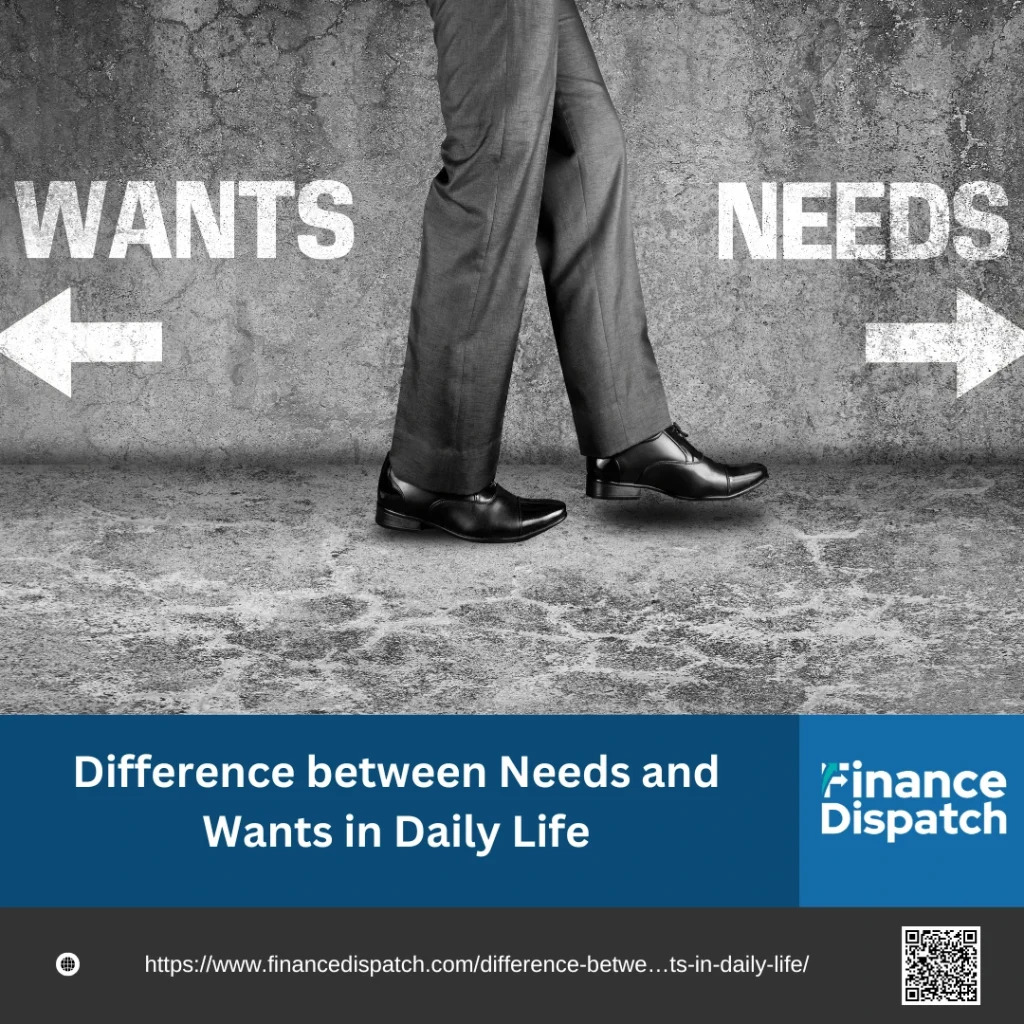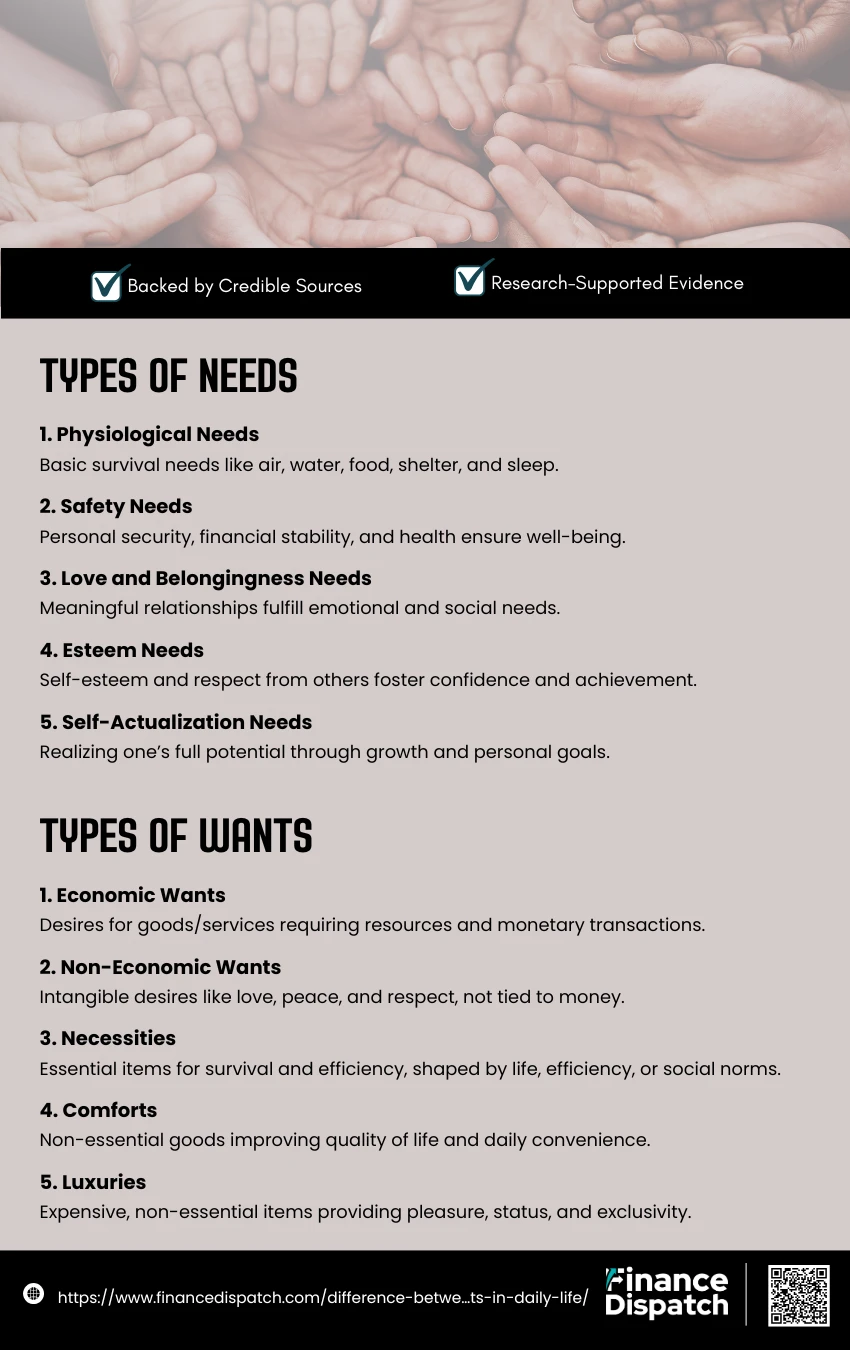In daily life, needs are the essentials required to maintain your survival, health, and basic functionality. These include items like food, water, clothing, shelter, and healthcare—fundamentals that ensure physical and emotional well-being. Needs provide stability and security, forming the foundation of your existence. For example, paying rent or buying groceries fulfills essential requirements that you cannot overlook. If these needs remain unmet, the consequences can be severe, affecting your ability to live and function effectively. By prioritizing needs, you establish a solid base for handling life’s responsibilities and maintaining a stable, productive, and healthy lifestyle.
Wants, on the other hand, represent desires that enhance your quality of life but are not essential for survival. These could include entertainment, dining out, luxury items, or recreational activities. Wants often stem from personal preferences, cultural influences, or aspirations and add comfort, enjoyment, or prestige to your life. For instance, upgrading to a premium smartphone or taking a vacation is wants that can provide satisfaction but are not crucial to your basic well-being. While fulfilling your wants can bring happiness, distinguishing them from needs is essential for maintaining financial balance and focusing on long-term priorities.
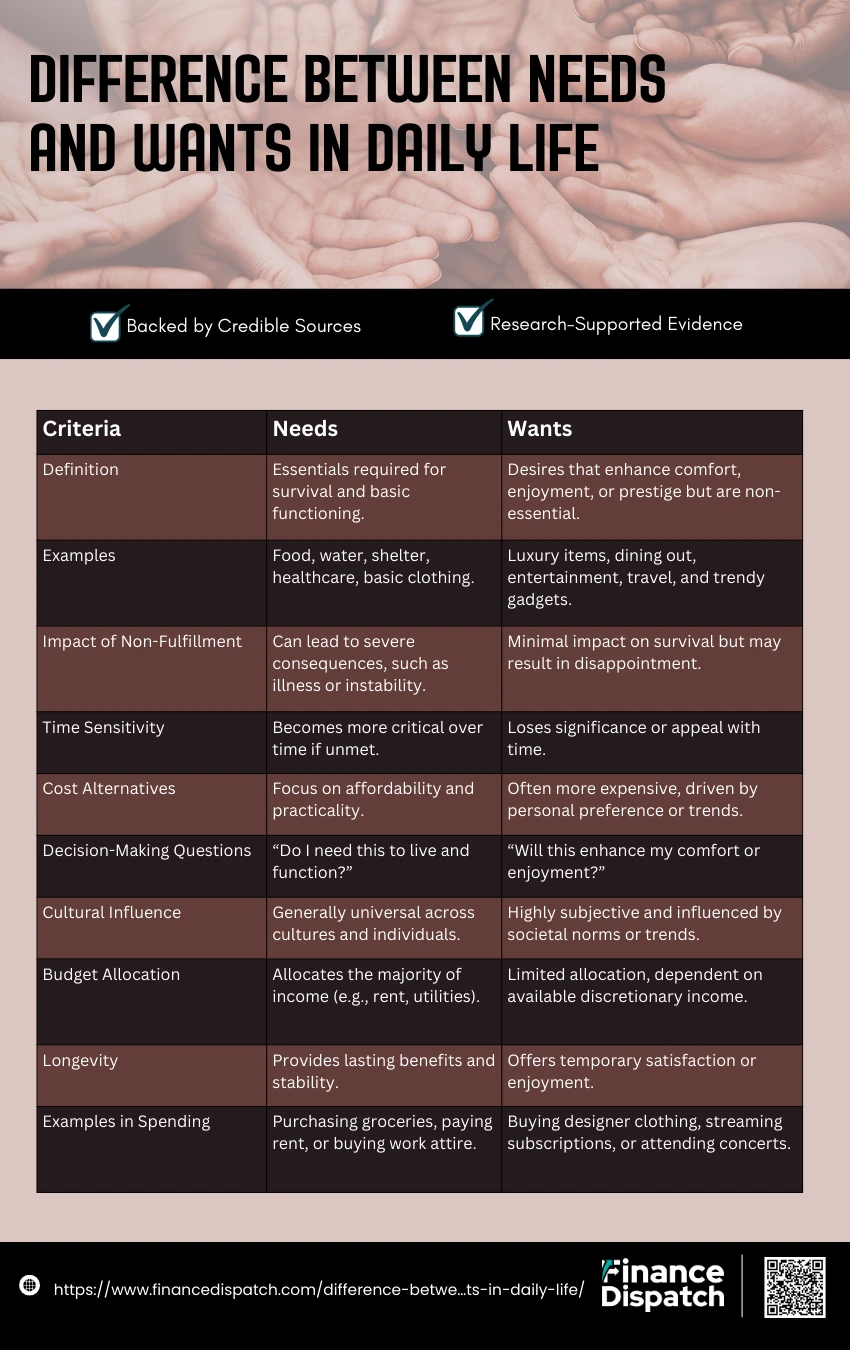
Difference between Needs and Wants in Daily Life?
In daily life, distinguishing between needs and wants is crucial for making thoughtful choices. Needs are the basic essentials required for survival, such as food, water, and shelter, while wants are additional desires that enhance comfort or enjoyment. The table below outlines the key differences between these two concepts to help you better prioritize and manage resources effectively.
| Criteria | Needs | Wants |
| Definition | Essentials required for survival and basic functioning. | Desires that enhance comfort, enjoyment, or prestige but are non-essential. |
| Examples | Food, water, shelter, healthcare, basic clothing. | Luxury items, dining out, entertainment, travel, and trendy gadgets. |
| Impact of Non-Fulfillment | Can lead to severe consequences, such as illness or instability. | Minimal impact on survival but may result in disappointment. |
| Time Sensitivity | Becomes more critical over time if unmet. | Loses significance or appeal with time. |
| Cost Alternatives | Focus on affordability and practicality. | Often more expensive, driven by personal preference or trends. |
| Decision-Making Questions | “Do I need this to live and function?” | “Will this enhance my comfort or enjoyment?” |
| Cultural Influence | Generally universal across cultures and individuals. | Highly subjective and influenced by societal norms or trends. |
| Budget Allocation | Allocates the majority of income (e.g., rent, utilities). | Limited allocation, dependent on available discretionary income. |
| Longevity | Provides lasting benefits and stability. | Offers temporary satisfaction or enjoyment. |
| Examples in Spending | Purchasing groceries, paying rent, or buying work attire. | Buying designer clothing, streaming subscriptions, or attending concerts. |
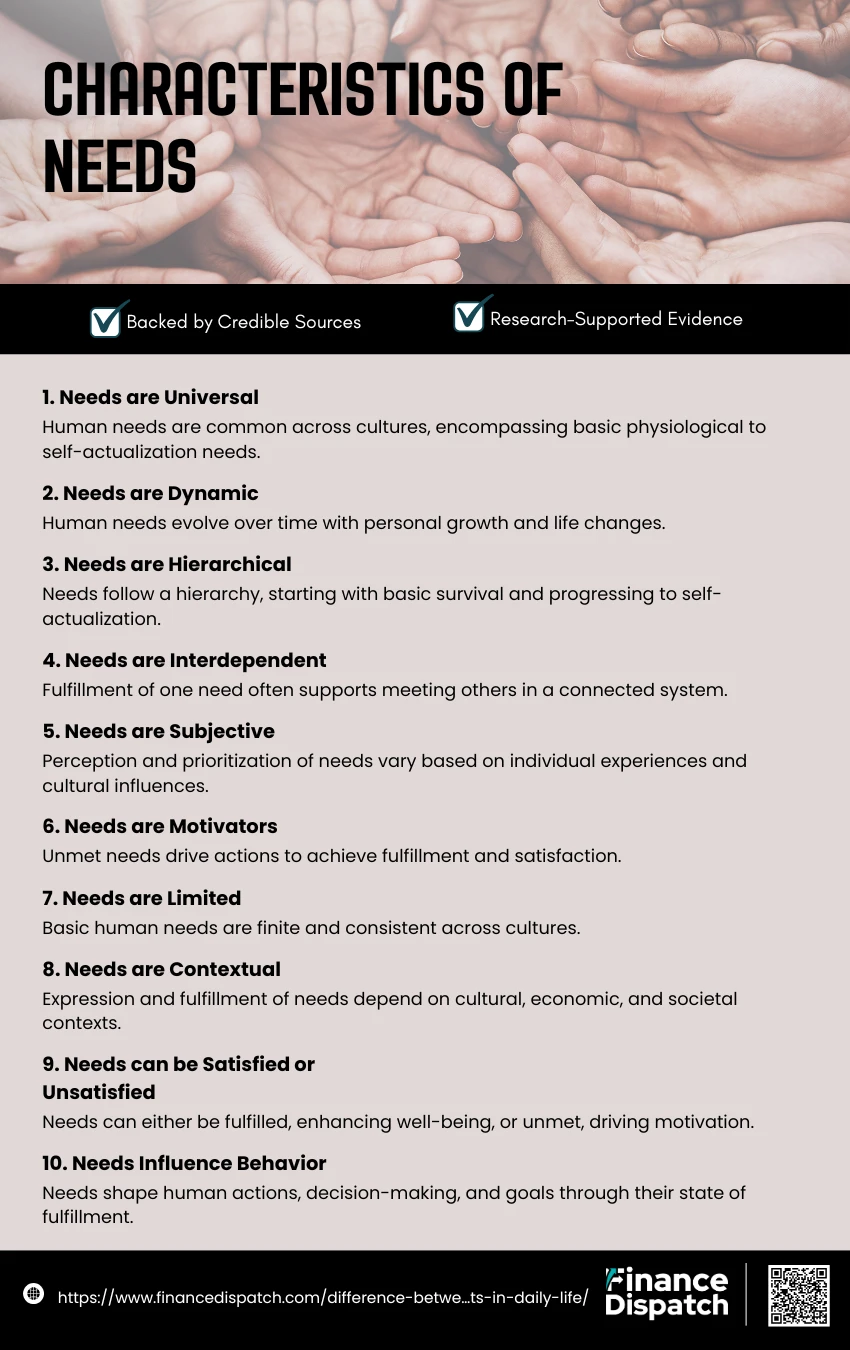
Characteristics of Needs
Needs are fundamental to human survival and well-being, serving as the foundation of our daily lives. They represent the essential requirements that must be met to maintain physical and mental health. Below is a list of key characteristics that define needs, helping to distinguish them from other aspects of human desires or preferences.
1. Needs are Universal
Human needs are universal, as they form the foundation of human survival and well-being across all societies. Maslow’s hierarchy of needs highlights the basic physiological, safety, love, esteem, and self-actualization needs shared by everyone. This universality underscores the innate drive to fulfill these needs regardless of cultural or societal differences. (1)
2. Needs are Dynamic
Human needs are not static; they evolve over time based on personal growth and changing circumstances. For example, while young children prioritize safety and love, adults often seek self-actualization or esteem. The dynamic nature of needs reflects the human capacity for adaptation. (2)
3. Needs are Hierarchical
Needs are arranged in a hierarchical structure, with basic physiological needs at the bottom and self-actualization at the top, as proposed by Maslow. This framework suggests that lower-level needs must be satisfied before higher-level aspirations can be pursued. Source: Verywell Mind
4. Needs are Interdependent
Human needs are interconnected, where fulfilling one need often facilitates the fulfillment of others. For example, meeting the need for belonging can enhance self-esteem, showing that needs function within a system of mutual influence. (4)
5. Needs are Subjective
Although certain needs are universal, how individuals perceive and prioritize these needs is highly subjective. Personal experiences, culture, and environment shape what individuals consider essential, making needs highly individualized. Source: Oxford Research Encyclopedias
6. Needs are Motivators
Unmet needs act as powerful motivators, driving individuals to take action to fulfill them. For instance, hunger motivates eating, while a desire for esteem prompts efforts toward achievement and recognition. (6)
7. Needs are Limited
Unlike desires, fundamental human needs are finite. Theories such as those by Manfred Max-Need identify a specific set of basic human needs that remain consistent across cultures, emphasizing their limited nature. (7)
8. Needs are Contextual
The way needs are expressed and fulfilled depends on the context, including cultural norms, economic conditions, and societal values. For example, safety needs may manifest as physical security in some societies and financial stability in others. (8)
9. Needs can be Satisfied or Unsatisfied
Needs can exist in a state of satisfaction or dissatisfaction. Fulfilled needs contribute to well-being, while unmet needs often result in discomfort or drive to achieve fulfillment. This duality forms the basis of human motivation.(1)
10. Needs Influence Behavior
Human behavior is significantly influenced by the state of needs. For example, unmet needs like hunger or safety compel individuals to act toward meeting them, shaping decision-making and goal-setting processes. (9)
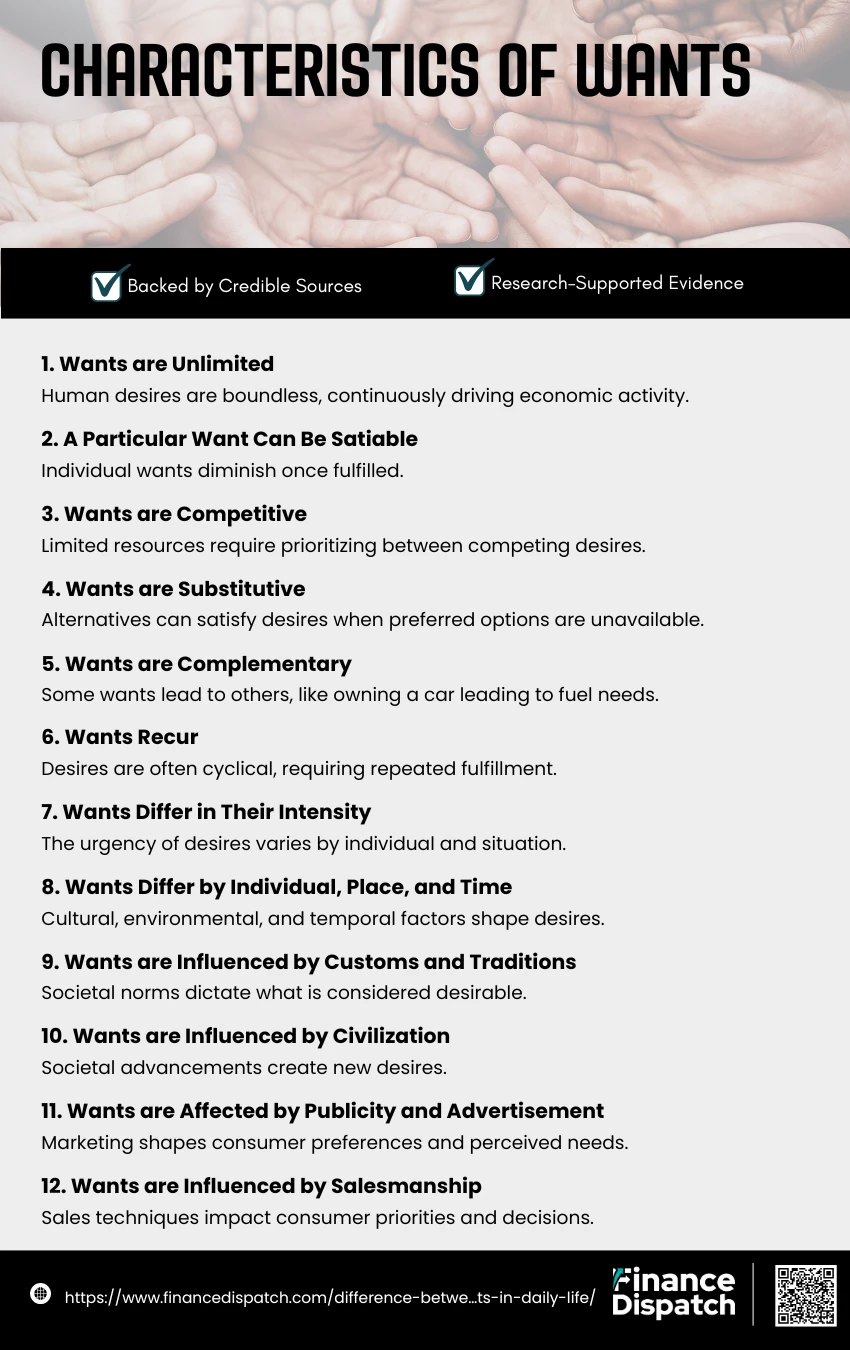
Characteristics of Wants?
Human wants exhibit several key characteristics that influence economic behavior and resource allocation. Below is an overview of these characteristics, each accompanied by authoritative references:
1. Wants are Unlimited
Human desires are boundless, encompassing a vast array of goods and services. This insatiability stems from the continuous emergence of new needs and aspirations, driving economic activity and innovation. (10)
2. A Particular Want Can Be Satiable
While the spectrum of human wants is limitless, individual desires can be satisfied. Once a specific need is met, the urgency to fulfill it diminishes, allowing individuals to prioritize other wants. (11)
3. Wants are Competitive
Limited resources compel individuals to make choices among competing wants. This necessitates prioritization, as satisfying one desire often means forgoing another, highlighting the concept of opportunity cost. (12)
4. Wants are Substitutive
When resources are scarce, individuals may seek alternative means to satisfy their desires. For instance, if a preferred product is unavailable, a substitute offering similar utility may be chosen. (13)
5. Wants are Complementary
Certain desires are interconnected, where fulfilling one leads to the emergence of another. For example, purchasing a vehicle may create a subsequent desire for fuel and maintenance services. (14)
6. Wants Recur
Many human desires are cyclical, resurfacing after intervals. Basic needs like hunger and thirst recur regularly, necessitating repeated fulfillment. (15)
7. Wants Differ in Their Intensity
The urgency of desires varies among individuals and situations. Some wants are pressing and demand immediate attention, while others are less critical and can be deferred. (16)
8. Wants Differ from Individual to Individual, Place to Place, and Time to Time
Cultural, environmental, and temporal factors shape human desires. A want prevalent in one society may be nonexistent in another, and desires evolve over time due to changing circumstances. (17)
9. Wants are Influenced by Customs and Traditions
Societal norms and traditions play a significant role in shaping individual desires. Cultural practices often dictate the goods and services deemed desirable or necessary. (18)
10. Wants are Influenced by Civilization
Advancements in society introduce new goods and services, creating novel desires. Technological progress, for instance, has led to the emergence of wants that were previously unimaginable. (19)
11. Wants are Affected by Publicity and Advertisement
Marketing strategies and advertisements can shape consumer preferences, creating perceived needs and influencing purchasing behavior. (20)
12. Wants are Influenced by Salesmanship
The skills and techniques employed by salespersons can significantly impact consumer decisions, persuading individuals to prioritize certain wants over others. (21)
Types of Needs
Abraham Maslow’s hierarchy of needs is a psychological framework that categorizes human needs into five levels, each building upon the previous one.
1. Physiological Needs
At the foundation of Maslow’s hierarchy are physiological needs, which are essential for human survival. These include necessities such as air, water, food, shelter, clothing, and sleep. Maslow emphasized that until these basic needs are met, individuals are unlikely to pursue higher-level aspirations. (22)
2. Safety Needs
Once physiological needs are satisfied, safety needs become prominent. These encompass personal security, financial stability, health, and well-being. A sense of safety is crucial for individuals to progress to more advanced stages of personal development. (22)
3. Love and Belongingness Needs
After achieving safety, the need for love and belonging emerges. This level involves forming meaningful relationships, such as friendships, intimate partnerships, and connections within social groups. Maslow noted that fulfilling these social needs is vital for emotional well-being. (22)
4. Esteem Needs
Esteem needs are divided into two categories: self-esteem and the desire for respect from others. Self-esteem involves feelings of dignity, achievement, and independence, while the latter includes status and recognition. Meeting these needs fosters confidence and a sense of accomplishment. (22)
5. Self-Actualization Needs
At the pinnacle of the hierarchy is self-actualization, which refers to realizing one’s full potential and seeking personal growth. This could manifest in various forms, such as pursuing creative endeavors, achieving personal goals, or seeking spiritual enlightenment. Maslow described this as the desire to become everything one is capable of becoming. (22)
Types of Wants
Human wants can be categorized into various types based on their nature and the degree of necessity.
1. Economic Wants
Economic wants are desires for goods and services that require resources to obtain and have a monetary value. These include basic needs like food, clothing, and shelter, as well as non-essential items such as electronics and automobiles. Satisfying economic wants typically involves engaging in economic activities to earn income, which is then exchanged for these goods and services. Economics City
2. Non-Economic Wants
Non-economic wants are desires that do not involve monetary transactions and cannot be satisfied through economic activities. They encompass intangible aspects such as love, respect, peace, and happiness. These wants are fulfilled through personal relationships, social interactions, and emotional well-being, rather than through the consumption of goods and services.(23)
3. Necessities
Necessities are essential goods and services required for basic human survival and efficient functioning. They are further divided into:
- Necessaries of Life: Fundamental needs like simple food, clothing, and shelter, without which human life would be difficult.
- Necessaries of Efficiency: Items that enhance one’s ability to work effectively, such as nutritious food and adequate rest.
- Conventional Necessaries: Goods deemed necessary due to social customs and conventions, like appropriate attire for specific occasions.(24)
4. Comforts
Comforts refer to goods and services that improve quality of life by providing ease and convenience, though they are not essential for survival. Examples include household appliances, comfortable furniture, and personal transportation. These items make daily activities more pleasant and can enhance overall well-being.(24)
5. Luxuries
Luxuries are non-essential goods and services that provide pleasure and status. They are often expensive and not required for basic living, such as high-end cars, designer clothing, and exclusive vacations. The consumption of luxury items is typically associated with higher income levels and can serve as a display of wealth and social standing.(24)
Conclusion
In conclusion, understanding and addressing life’s challenges with clarity and purpose is essential for personal growth and success. By differentiating between priorities, identifying common obstacles, and applying effective strategies to overcome them, you can cultivate resilience, enhance productivity, and achieve a sense of balance in your life. Whether it’s managing time, finances, or relationships, approaching these areas with thoughtful solutions ensures not only survival but also progress toward long-term goals. Embracing challenges as opportunities for learning and improvement allows you to thrive, creating a fulfilling and meaningful life journey.
Refrences
- Simply Psychology. “Maslow’s Hierarchy of Needs.”
- ScienceDirect. “Dynamic Needs in Psychology.”
- Verywell Mind. “Maslow’s Hierarchy of Needs Explained.“
- SpringerLink. “Interdependence of Needs.” https://link.springer.com
- Oxford Research Encyclopedias. “Subjectivity in Needs.”
- American Psychological Association. “Needs and Motivation.”
- Encyclopedia Britannica. “Basic Human Needs.”
- Cambridge University Press. “Contextual Influence on Needs.“
- ResearchGate. “Needs and Human Behavior.”
- Gagnier, R. (2000). The Insatiability of Human Wants: Economics and Aesthetics in Market Society. University of Chicago Press.
- Kamenetzky, M. (1981). The economics of the satisfaction of needs. Human Systems Management, 2(2), 101-111.
- Cambridge University Press. (n.d.). The Basic Economic Problem. Cambridge Assets
- Mayo Research Institute. (n.d.). On Need, Wants, Resources, and Limits. Mayor Research
- The Global e-Schools and Communities Initiative. (2019). Characteristics of Human Wants.
- New Economics Foundation. (2014). Basic human needs: what are they? New Economics Foundation
- OpenStax. (n.d.). What Is Economics, and Why Is It Important? Social Science LibreTexts
- Cambridge University Press. (n.d.). Social wants, normative concerns, and interests. Cambridge University Press
- Wikipedia contributors. (2023, October 30). Human behavior. In Wikipedia, The Free Encyclopedia. Wikipedia
- Wikipedia contributors. (2023, October 30). Humanistic economics. In Wikipedia, The Free Encyclopedia.
- Wikipedia contributors. 2023, October 30). Goods and services. In Wikipedia, The Free Encyclopedia.
- Wikipedia contributors. (2023, October 30). Public economics. In Wikipedia, The Free Encyclopedia.
- McLeod, S. (2024, January 24). Maslow’s Hierarchy of Needs. Simply Psychology. Retrieved from Simply Psychology
- Human Wants: Meaning, Types and Their Characteristics. Economics City. Retrieved from Economics City
- Human Wants: Necessaries, Comforts and Luxuries. Your Article Library. Retrieved from Your Article Library



